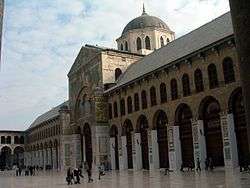Murad Pasha Mosque
| Murad Pasha Mosque جامع مراد باشا | |
|---|---|
 Murad Pasha Mosque in 1880 | |
 Location within Old Damascus | |
| Basic information | |
| Location |
|
| Geographic coordinates | 33°30′13″N 36°18′05″E / 33.503598°N 36.301412°ECoordinates: 33°30′13″N 36°18′05″E / 33.503598°N 36.301412°E |
| Affiliation | Islam |
| Region | Levant |
| Status | Active |
| Architectural description | |
| Architectural type | Mosque |
| Architectural style | Ottoman architecture |
| Completed | 1568 |
| Specifications | |
| Dome(s) | 1 |
| Minaret(s) | 1 |
| Materials | Stone, marble, tile |
The Murad Pasha Mosque (Arabic: جامع مراد باشا, transliteration: Jami Murad Pasha) is an early Ottoman-era mosque and mausoleum in Damascus, Syria, located in the Suwayqa sector of the Al-Midan quarter. The mosque was erected and named after Murad Pasha, who served as the Ottoman governor ("wali") of Damascus between 1568-1569. The mosque was built in 1568.[1] The mosque is also known as the Naqshbandi Mosque (Arabic: جامع النقشبندي) after the Naqshbandi sufi order which it served as a center for.[2]
Architecture
The mosque is built in the style of Ottoman mosques, rather than the prevalent styles in Arab lands. The building is noted for its similarities with other Ottoman-era mosques in Damascus, including Tekkiye Mosque and the later Darwish Pasha Mosque.[1] The walls of the mosque were built using alternating lines of black and white stones.[3] The mosque is built around a large courtyard ("sahn"), which features an elaborate fountain that was used for ablution ("wudu"). The courtyard is surrounded by an arcade of domed cells ("riwaq"), which were used as sleeping rooms by students and scholars at the mosque. The structure's walls are decorated with elaborate qashani tile panels. The interior rectangular prayer hall is roofed by a typical Ottoman-style lead-covered dome.[2] The prominent hexagonal-shaped minaret is singled out as the only element built in "the image of the minarets of the Arab lands."[1] The mosque also holds in one of its corners the mausoleum where Murad Pasha was buried. The mosque's main gate holds kufic inscriptions that mention the mosque's construction date and its patron's name.[3]
References
- 1 2 3 Kafescioǧlu, Çiǧdem (1999). ""In The Image of Rūm": Ottoman Architectural Patronage in Sixteenth-Century Aleppo and Damascus". Muqarnas. BRILL. 16: 70–96. doi:10.2307/1523266.
- 1 2 Rihawi, Abdul Qader (1979). Arabic Islamic Architecture in Syria. Damascus: Ministry of Culture and National Heritage. p. 226.
- 1 2 Asawda, Fadi (18 September 2009). "جامع "النقشبندي"... نسخة "التكية السليمانية" في حي السويقة". eSyria.sy. Retrieved 4 March 2011.



